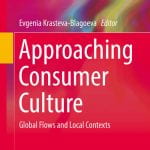Approaching Consumer Culture, published by Springer, is now available as both an e-book and hard cover. Both Professor Mike Featherstone and Dr Tomoko Tamari have contributed to this collection which analyses the impact of Western consumer culture on local cultures and consumption in Southeast Europe and East Asia.
- Introduced by Professor Mike Featherstone, a leading scholar with worldwide influence.
- Presents a unique compilations of texts on Southeast European and Asian consumer cultures
- Broadens the traditionally Western-orientated scholarship on consumerism
- Aligns with texts applicable to university courses in cultural anthropology, cultural studies and sociology
- Targets not only a Western market, but Japanese, Chinese and Indian readership as well
Consumer Culture and its Futures: Dreams and Consequences
Mike Featherstone: pages 1-46

ISBN 978-3-030-00226-8
This chapter addresses a range of questions about the dreams and consequences of consumption. The roots of consumer culture can be traced back to long-standing dreams of abundance and unrestricted consumption. With consumer culture now the dominant force central to the maintenance of the contemporary neoliberal global economy, the chapter asks the question how far are these dreams still viable? Today’s cultural heroes prominent in the media are still the rich, superrich, and celebrities, who enjoy excessive luxury lifestyles. Yet what are the consequences of 200 years of increasing consumption? Some would argue that the ecological consequences of a consumer society are evident in climate change and impending planetary disaster through the accumulation of excessive waste and unknown risks. If the unintended consequences now threaten planetary existence, what is the potential for thinking beyond consumer culture? Does consumer culture merely provide an extension of work, with increasing surveillance through digital devices effectively locking people into more compulsive patterns of behaviour with the loss of genuine free time and sociability? Can consumer culture still deliver the good life and happiness? The chapter explores alternative ways of being together that could reverse the excessive individualism, egoism of consumer cultures.
Modernisation and the Department Store in Early-Twentieth-Century Japan: Modern Girl and New Consumer Culture Lifestyles
Tomoko Tamari: pages 237-255
This chapter focuses on the way in which the department store became a key site for the constitution of Japanese modernity in early-twentieth-century Japan. The first Japanese department store, Mitsukoshi, not only provided new goods along with pragmatic ideas of how to use and how to evaluate them, but also sought to promote images and advice on how to integrate the “new” into existing lifestyles and value systems. Mitsukoshi offered a new type of consumer experience to explore how “to be modern.” This can be well tuned with the government policy, “reform of everyday life,” which encouraged people to be more efficient and rational in everyday practices. This policy was also well fitted to new middle class who sought to new lifestyle which would be modern. To be modern was particularly important for an urban working woman who was often seen as a modern girl. Department store provided them with not only a set of ideas to be modern, but also a new aestheticized urban consumer space as a stage to perform. Hence, Mitsukoshi served both as a political device to create modern citizen and as a cultural device to produce modern consumers in political and cultural transition era of Japanese modernization.